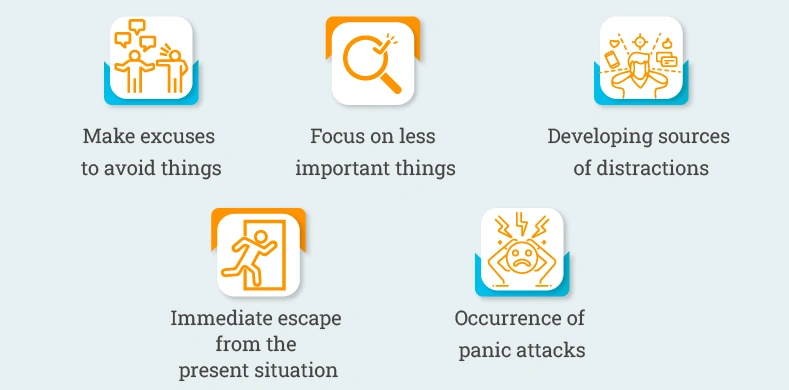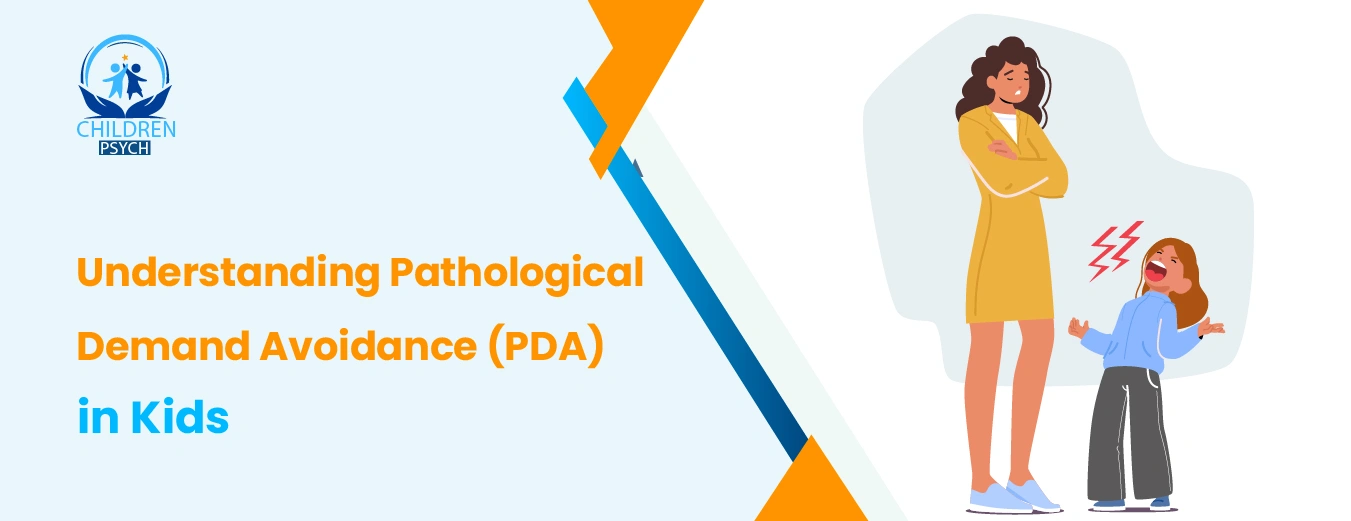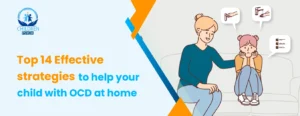How many times have you noticed that your child shows extreme tantrums in response to everything that they consider a demand? This is Pathological Demand Avoidance (PDA), a profile within autism spectrum disorder. Children with PDA show extreme levels of resistance to instructions and requests of others, especially seniors.
This article is a complete guide to ‘’ Pathological Demand Avoidance in Kids. After reading this article, you will get a detailed insight into each aspect of PDA in kids. So read this article now!
What is Pathological Demand Avoidance (PDA)?
Pathological demand avoidance is a condition in which children exhibit high-intensity mood swings or negative behavioral patterns. They always show a negative response to every single thing that they perceive as a demand. Children feel anxiety with each demand and then show a response to it with avoidance behavior. Instead of following the instructions of their parents or seniors, they avoid or ignore them. Moreover, this negative or undesired behavioral pattern is usually diagnosed in children who are suffering from autism.
Avoidance & Its Forms
There are different forms of avoidance that children show in case of PAD, such as:

- Make excuses to avoid things
- Focus on less important things
- Developing sources of distractions
- Immediate escape from the present situation
- Occurrence of panic attacks
Other Main Behavioral Features of PDA are as Follows:
- Severe mood alterations
- Less preference for social interactions
- Greater obsessive need to control
- Perceive themselves as adult and behave like them.
- Highly dominating behavior
- Self-harming behavior
- Aggressive behavior
What’s the Background of PDA?
Multiple studies have reported that approximately 20% of children who are battling with autism disorder show the pathological demand avoidance behavior.
You might have experienced a situation multiple times in which your child exhibits avoidance behavior on any demand or expectation. For example, there is a speech competition in your child’s school and you have have work hard to prepare your child. But when the time comes, your child freezes up. Instead of speaking in front of an audience, they feel an urge to run away or show an anger outburst to every second person who is present at that moment.
Parents, teachers, and the entire society always label the PDA kids as spoiled or rude. However, it is all about anxiety. The regular demands, instructions are the ones that trigger the anxiety and associated avoidance behavior in children. Due to a hyper-sensitive nervous system, they face multiple difficulties in different areas of their life, but the rate is higher in academic life.
What Does Pathological Demand Avoidance Behavior in Children look like?
Meeting friends and going out with loved ones, getting dressed up, sitting at a table and starting to read new stories or books, making drawings on paper are those acts that every child loves to do and also has the in-built skills. But in the case of PDA, children only prefer to do such things when they feel motivated. They do not feel interested in any activity that someone asks them to do. Even if the parents say to them that they should clean their room, they consider it a demand and show defiance or hostile behavior. However, when they receive multiple demands, then there are fewer chances that they melt down, as in 90% of cases, they explode and highly react in a negative manner.
Furthermore, due to pathological demand avoidance behavior in children, most of the parents have to face the embarrassment. As parents have a belief that their child can do that specific thing, but in reality, when their child is asked to do that by any other person then they refuse or show a negative response to the command. Parents feel more frustrated when their child is undergoing the process of evaluation.
However, this behavioral pattern is not limited only to school-going children, as older children and adolescents are also categorized in the list of PDA. Even though their parents are sure about their mental strength and intelligence their they face difficulty in completing their academic projects and achieving excellence.
There is a high frequency of meltdowns in the case of young children. Therefore, it is quite difficult to differentiate pathological demand avoidance and typical tantrums or mood swings in kids.
What are the Triggers of PDA Behavior?
It is still unclear what the exact or major cause of pathological demand avoidance in kids but the following are considered as those situations that can trigger the extreme avoidance behavior in children:
Direct Instructions & Criticism
On every demand or expectation, the human brain receives the signal to further proceed. Instead of just instructions, the autonomic system perceived it as a threatening signal. The nervous system gets activated, and the fight, fight, fawn, or freeze response is generated. Moreover, children feel that the other person is not just asking them to do that, but criticizing them. This in turn results the high high-intensity avoidance behavior in children.
Poor Executive Functioning
Poor executive functioning can also cause pathological demand avoidance behavior in kids. Affected children find it hard to follow their daily life schedules or interact in any social environment. Instead of understanding the situation, they always misinterpret it and face multiple challenges in their life.
Instructions for Performing Activities
Simple and easy tasks like completing homework, brushing hair and teeth, and getting dressed even trigger their stress and anxiety, and they start showing a high level of avoidance behavior.
Sudden or Unexpected Changes
If children receive any demands or instructions that are not linked with their daily life routine, then they also start taking stress and exhibit avoidant behavior.
Social things or Situations
Not every child feels confident in the presence of others. Due to the pathological demand avoidance behavior, children feel shy and less confident in social interactions. They think that they can not fulfill their expectations and therefore prefer to stay away from them.
Other major triggers of PDA in kids
- Previous life negative experiences with demands
- Higher need to control things
- Increased sensory insensitivities
- Social and communication issues
- Executive functioning issues
Child Evaluation of PDA
As a parent, you can also evaluate your child to identify the PDA by the following:
Is there any specific trigger factor resulting in the avoidance behavior in your child?Does your child always make excuses?Does your child get anxious when someone instructs them?
If the answer to all the above questions is yes, then it indicates that your child is having this negative behavioral profile. Your child’s resistance and avoidance behavior is at an extreme level due to the everyday demands or expectations.
What are the Challenges that Children Face with PDA?
PDA is not only complicated for the children but also their parents, as they have to deal with them. In PDA, children are at a high risk of showing defiance towards the multiple demands and expectations. According to them, every single command is a signal of a threat. Moreover, they have to face multiple challenges in different areas of their life, including their home, school, and social life.
Challenges at homeplace
If a parent normally says to a child that brush their teeth, complete their homework, or sleep early, then they resist and avoid following their instructions. This, in turn, affects their personal life as well as academics.
Challenges at school
Children with pathological demand avoidance have to struggle every moment that they spend in school. They not only have to follow the instructions of their teachers, but also have to socialize with other students. In some cases, children show lenient behavior, while most of them are those who do not understand what and why their teachers are saying to them. Likewise, they avoid the importance of making bonds with others in school.
Challenges in social life
Children with PDA are social, but in reality, they have to struggle in communication and understanding the concepts or opinions of others. In major cases, they make efforts to show dominance in conversations with others. Although they just want to take control of the situation, others misunderstood them and judged them as bad.
Children grappling with autism spectrum disorder show less flexibility in their rigid behavior as compared to other children. Moreover, they also have reduced social skills and therefore face difficulties in making and strengthening bonds with their friends or loved ones. When they get instructions from their parents or any other person, they do not understand that and feel like it came out of nowhere, which can be threatening for them.
Children who are free from any mental issue do their routine things without showing any resistance. However, children with autism do not feel any motivation even in those activities in which they feel interested. They always misinterpret the situations like ‘’ if a teacher says to them that I’m present in the class and all of you have to stay quiet and learn. Then normal kids will understand it and follow the instructions. However, PDA kids misunderstand this and feel like the teacher is having controlling behavior and forcing every child to obey the order.
Perplexing behavior
Children with autism are more likely to show perplexing behavior. Even if they are highly intelligent and have a strong IQ, they get confused many times. For example, if the teacher instructs the children to solve a math quiz, then every child will do that. But they start thinking that everyone is doing that. I don’t need to do that, so I should do something else, like drawing or sketching. If the teacher then asks them why they are not doing this, then they get upset or show anger in front of others in the classroom. This not only affects their academic life but also their relationship with teachers and classmates.
Can a Non-Autistic Child Have PDA?
Yes, there is a possibility that pathological demand avoidance occurs these children who are not suffering from autism disorder. Most people believe that openly autistic children have PDA, but in reality, it is a pattern of behavior that can also be seen in those children who are not suffering from autism.
Moreover, multiple studies have reported that the behavioral patterns or underlying neurobiological profiles are distinct in children having PDA, not autism, as compared to those who have both autism and PDA. So, although PDA is associated with autism but it can also be found in children who are not victims of PDA.
PDA: No Recognition as a Separate Diagnosis
Pathological demand avoidance is not officially identified as a distinct diagnosis. In addition, it is also not included or listed in ICD-11 and DSM-5. Some believe that PDA is a profile of autism, and only children with autism suffer from this condition. While some, on the other hand, have a major belief that it is a combination of negative behaviors that every individual, including a child, adolescent, or adult, shows in their life under the influence of multiple factors. Moreover, there is another major belief that PDA in kids is also linked with neurodivergence.
Although there is no official or formal diagnosis, the concept of PDA is grabbing the attention of parents, advocacy groups, and clinicians. They consider the major challenges that children face due to their avoidance behavior in kids and strive for coping ways or strategies to help their child in dealing with them.
Most of the parents get confused with the occurrence of PDA and autism in children. Therefore, they asked whether their child has ‘’PDA autism’’. Both are different conditions, as autism is a disorder while PDA is a different behavioral pattern. Moreover, children with autism and PDA also need a different type of support to deal with both conditions.
Furthermore, the autism diagnosis with PDA becomes more complicated when children are diagnosed with any other co-occurring condition, such as anxiety, ADHD, or any form of mood disorder.
PDA Scale of Distress
The PDA scale is a visual representation that explains the increasing intensity or occurrence of anxuety and resistant behavior to demands.
- The green zone is a calm region as children are silent and calm. In this area, they intercat with others but meanwhile use some source of distractions to avoid certain demands.
- In the yellow region, children start showing avoidance or withdrawal behavior. Instead of communicating with others, they prefer isolation.
- The orange zone indicates that children can not fulfill the demands and expectations of their parents, seniors, or others.
- Red Zone indicates the specific time where children with PDA require additional support to manage their behavior, as their aggressive behavior and fight, fight, and freeze responses get activated.
The Process of PDA Testing
The main process of PDA evaluation in children comprises the following steps:
Step 1: Initial appointment that only involves parents
Step 2: Direct or face-to-face appointment with children
Step 3: Getting feedback from friends or other loved ones of children who are close observers of the child’s behavior
Step 4: PDA profile determination
How to Deal with PDA in kids?

Low-Demand Parenting
If parents are putting more demands on their children, then they exhibit more pathological avoidance behavior. However, if they follow the low-demand, low-arousal approach, then they can control their child’s avoidance behavior. When they receive fewer demands, they remain satisfied and feel pleasure.
Understand Your Child
As a parent, the first thing you should do is to understand your child. Do not forget that they are not doing it intentionally. This is just a nervous system disability. They are not bad by birth. They are going through this situation and need your help.
Balance the Demands
If you are focusing low-demand parenting approach, then it does not mean that you have to bend down in front of your child. Do not completely lower your demands for your child, as a little bit of anxiety is good for them. Low levels of anxiety help them get motivated to learn and move forward in life.
Educate Them
Teach your child that whatever you or another person says to them is not a command or something to follow up on you. If they follow the instructions, then they can get multiple benefits. However, if they feel that the instructions are not appropriate or something that is misleading, then they can discuss it with them. Moreover, they should also make efforts to identify the triggers or these factors that can provoke their anxiety and ultimately extreme avoidance behaviors.
Indirect Communication
If you don’t want to make your child anxious, then you should follow the indirect communication. Instead of directly giving commands or instructions to your child, try to show your concerns by asking certain questions or making suggestions. For example, don’t say to collect all your toys and place them in the cupboard. Instead of this, say to them‘’ It will be great to see a clean and tidy room, so we should do it together.
Develop the Adaptive Skills.
Parents should focus on developing the adaptive skills in their child that help them to navigate all the challenges and improve the quality of life.
Consider Your Child’s Strengths & Interests.
You should be familiar with your child’s interests and strengths. You can use their interest factors as a source of motivation. Likewise, by considering their strong points, you can guide them to do or perform different activities without getting overwhelmed.
Give Them Varied Options.
Do not give your child just one instruction to complete your order. Instead of this, you should give them multiple options that they can choose from according to their interest or preferences. Make them feel that everything is under their control and they can do whatever they want.
Trust on Time
Good things always take time to happen. If you are not easily communicating with your child, then there is nothing to worry about. Have some patience and try the ways that can help in reducing the avoidance behavior of your child.
Discuss Everything With Your Child
If you directly impose your order on your children, then they will always show resistance. So, try to have a discussion with your children in a lighter mood. Ask them what they are facing and then help them develop coping strategies accordingly.
Show Your Supportive Behavior.
Always appreciate your child’s positive things and give them rewards. Do not criticize them for their negative behavior; otherwise, it can promote avoidance behavior.
Show Some Flexibility
Remember that there is a greater possibility that on some days, your child can show the result. Your child doesn’t always need to follow your instructions. So you should also be flexible and adaptable so you can make a better bond with your children without making any greater adjustments.
Predictable Routines
If your child is following the same or a predefined daily routine schedule, then there is a lower possibility of anxiety and depression. However, those children who are more subject to unexpected instructions, commands, or orders are more prone to mental health issues.
Do Not Take it Personally
Don’t forget that your child’s extreme level of avoidance behavior is due to anxiety. Don’t take it personally that they are denying your orders or instructions. Instead of getting complete control over them, focus on the ways that you can minimize the pathological avoidance behavior in kids.
Find Professional Help
If you feel that you are unable to help your child in overcoming the pathological demand avoidance and they are facing multiple difficulties in their life, then you can seek professional help. Find out those experts who have specialization in treating PDA and autism.
Final Remarks
In Pathological demand avoidance, children resist all those things that they feel like a demand. Although it’ss natural that children avoid doing certain things but if this condition persists, then it indicates the PAD. Several factors can trigger the PDA in kids, but with the help of some top effective strategies, it can be managed in kids.
Children’s Psych: An Ideal Platform for Your Child’s Mental Stability
Children Psych is a leading platform where you can find comprehensive mental health solutions for children and adolescents. Whether your young one is battling with anxiety, depression, ADHD, OCD, or bipolar disorder, we have the best psychiatric solutions that are tailored to the individual needs of each child.
Our devoted child psychiatric nurse practitioners are proficient in providing personalized treatment plans so that each child and adolescent can live a stress-free and happy life.
Frequently Asked Questions
What is the meaning of PDA?
PDA stands for pathological demand avoidance. It is a specialized behavioral pattern in which children show extreme resistance to all things, commands, or instructions that they consider demanding from others.
How did the PDA term originate?
The term PDA was first coined in the 1980s by a British psychologist, Elisabeth Newson.





